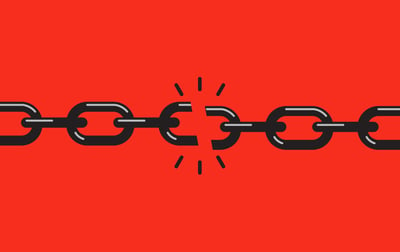
If you’re new to SEO, you’re probably feeling very overwhelmed with how much information there is to consume on the topic.
There are endless tactics and nuggets of advice just vying for your attention and readership. Might I might be so bold as to add one of my biggest pieces of advice into the mix? Stay away from black hat SEO.
Even though you’re still learning the ins and outs, you probably already know the basics of SEO, like how the purpose of Google and other search engines is to provide the best possible results to their users.
And you probably already know search engines help these users have a great search experience by using an algorithm to pull only the cream of the crop of content to the top of the search engine results pages (SERPs). This is why SEO is so important. If you want your content to rank, then you need that algorithm to love what you’re putting out there.
What you may not know is that there are a few different sets of techniques and schools of thought for how to get your content to rank: white hat SEO, black hat SEO, and their sometimes-sketchy lovechild, grey hat SEO.
We’ll talk a little about each one, but our focus here will be on what black hat is, why it sounds like a good idea (but isn’t), some common tactics, and how you can avoid being in violation of search engine guidelines.
Remember those old Western films where the hero would wear a crisp white hat and take down the bad guy wearing the black hat? Well, similar to that, black hat tactics are the “bad guys” of the SEO world. They’re used by websites trying to increase their ranking in ways that violate the webmaster guidelines of search engines like Google.
Instead of setting out to provide users with actual content of value, black hat SEO tries to fool search engines into earning higher rankings in the SERPs. These methods don’t provide anything truly of value to website visitors, can create an unpleasant user experience, and will hurt your website in the long run.
You might be thinking, what a search engine doesn’t know won’t get me in trouble, right? Wrong. Because if you’re utilizing black hat methods, it’s only a matter of time before you’re caught by the search engine and punished. Sites that are found to have violated a search engine’s guidelines will see their rankings suffer. And that’s not good.
Just like the handsome, smooth talkin’ villain in the Western movies, black hat SEO looks attractive. It can appear to be a quick and easy way to increase your website’s traffic and ranking, especially when compared to the time and effort that’s required by white hat methods.
The results of wholesome, white hat SEO don’t show up overnight. You can’t expect to post a few keyword optimized articles to your blog and suddenly be at the top of Google’s SERPs. It’d be like going to the gym for one hour and expecting rock hard abs the next morning. As frustrating as it can be, that’s just not how it works— white hat SEO takes time and dedication. In fact, it typically takes anywhere from 4 to 6 months to start seeing any results.
It can be hard for some to use the resources now for something that might not pay off for several months. These folks are easily lured into black hat by promises of fast results and quick ranking boosts.
Stay strong, my friends, and don’t resort to the shady tactics!
So what SEO tactics are considered black hat? Good question! Let’s take a look at some of the practices you’ll want to steer clear of when creating a content marketing strategy.
Poor quality content is one of the most common forms of black hat SEO and is a big no-no. Subpar website content doesn’t serve a searcher’s query and can come in several forms:
The key to avoiding bad content is to create your own relevant, original content. We’ll discuss this in a bit.
This is where you show the search engines crawling your website different content than what users see when they visit your page. Some do this in order to rank for keywords that really don’t appear on the page or use it to hide spammy content. While adapting content to your different user groups (i.e. mobile vs. desktop visitors) is acceptable, attempting to fool the search engines as to what is really on your site is not.
You’ve probably heard the old adage “too much of a good thing can be a bad thing”. This holds true with keywords. Keyword stuffing is the practice of packing as many keywords as possible onto a webpage in an attempt to manipulate the search engines into ranking for those phrases.
Not only is it a violation of the webmaster’s guidelines, but it also creates an unpleasant user experience. No one wants to read an article that unnaturally repeats the same phrases over and over again with slight wording variations. It’s hard for a human to miss an article like this, so you know the search engines certainly won’t overlook it.
| Related: Don't spoil your chance of ranking before you even hit publish. Learn what keyword cannibalization is and why it's important. |
Links should be earned because a website or piece of content is actually useful, relevant, and worthy of linking to. Links that are made with the intention of manipulating ranking may be considered part of a link scheme, which is a violation of Google’s guidelines. Here are some common link schemes:
There’s a number of other sketchy SEO tactics out there that should be avoided at all costs. This includes practices like...
| Abusing rich snippets and structured data |
| Creating hidden links and text |
| Sneaky redirects |
| Pages created with malicious intent |
All of these could be detrimental to your page rank. And besides that, they just aren’t cool.
There are a number of SEO tactics that border between white hat and black hat. They are the practices that are not explicitly outlined by the search engines, so it’s hard to tell exactly where they fall between black and white.
Grey hat is important to pay attention to, though, because understanding it can mean the difference between a boost in rankings and lost traffic. As the search engines evolve, what could be considered gray hat at one point may be black or white later; because of this, it’s always important to stay on top of updates and news related to SEO.
It can be hard to say when, exactly, grey hat turns into black hat, so it’s always good to err on the side of caution. If you have a feeling that an SEO tactic that you’re utilizing is a little sketchy or unethical, research some more or don’t do it. It’s better to be safe than sorry.
Of course, in the movies, the hero with the white hat always emerges victorious in the end. And if you utilize white hat SEO to improve your search engine rankings, you will too! Here are some ways you can increase your rankings the white hat way:

Like the old proverb says, slow and steady wins the race. You won’t see overnight results with white hat SEO, but when you do, it’ll all be worth it. Stay away from the sketchy black hat means of bettering your rankings, and you’ll be golden!
Need help using the proper channels for improving your SEO? Don't go the black hat route. Have an arsenal of SEO tools at your disposal to make sure your white hat SEO wins the race.
Krista Doyle is the Director of Content at Content Is Queen Marketing, an SEO-focused content marketing agency located in Austin, TX. Prior to starting CIQ Marketing, Krista spent 3 years at the e-learning startup Aceable focusing on content creation and SEO initiatives. Before moving to Austin, she lived in Los Angeles where she was a freelance writer for lifestyle publications like Thought Catalog, HelloGiggles, and The Conversation. When she’s not writing and SEO-ing, you can find Krista hiking, kayaking, eating every breakfast taco Austin has to offer or watching Friends for the millionth time with her wife Kelly and dog Franklin.
You might check your domain authority as often as you check your bank account, but what...
 by Brooks Manley
by Brooks Manley
Some content gets clicks. Great content gets shared. But linkable content? That’s the kind...
 by Soundarya Jayaraman
by Soundarya Jayaraman
The increasing competition in the online marketing sphere makes it hard to get your content...
-1.jpeg) by Momina Ayaz
by Momina Ayaz
You might check your domain authority as often as you check your bank account, but what...
 by Brooks Manley
by Brooks Manley
Some content gets clicks. Great content gets shared. But linkable content? That’s the kind...
 by Soundarya Jayaraman
by Soundarya Jayaraman


